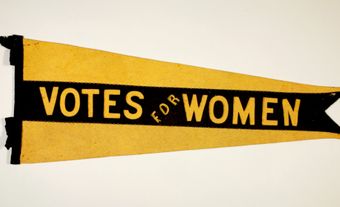The Fur Trade
For nearly 250 years, from the early 17th to the mid-19th centuries, the fur trade was a vast commercial enterprise across the land we now call Canada.
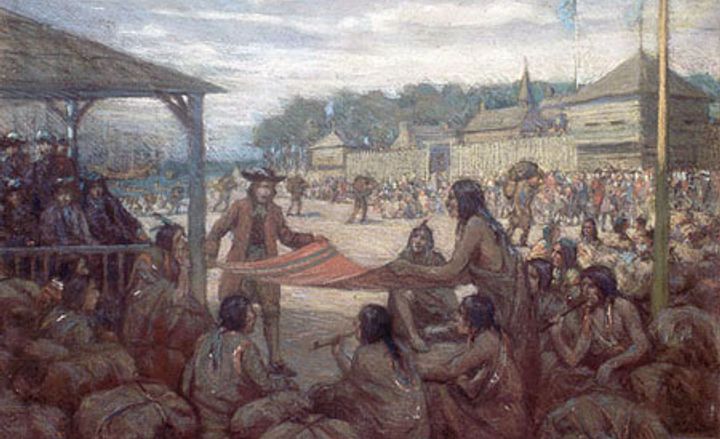
-
Fur Traders Indigenous Peoples
Cuthbert Grant Becomes Warden of the Plains
Fur trader and Métis leader of the battle of Seven Oaks, Cuthbert Grant was appointed warden of the Plains by Hudson’s Bay Company governor George Simpson in 1828. For at least 25 years, Grant and his followers served as providers and protectors of the Red River Colony.
-
January 01, 1500

Indigenous Peoples
Huron-Wendat Village Councils
Civil and war-related affairs among the Huron-Wendat are determined by respective village councils. Decisions are reached by consensus. All men over 30 are council members but women have little-to-no say in council affairs. (Note: The exact date of this event is unknown. The date provided here is an estimate.)
-
January 12, 1598
Government & Crown
La Roche's Monopoly
The Marquis de la Roche received a fur-trade monopoly to New France. He landed with a party on Sable Island, today in NS. Only 11 of the 40 colonists survived to be rescued 5 years later.
-
January 01, 1603
Indigenous Peoples Alliances & Treaties
Samuel de Champlain Allies with Montagnais-Naskapi
Samuel de Champlain formed an alliance with a Montagnais group in the year 1603, laying the foundation for French-Indigenous relations. Starting in 1830, the Hudson's Bay Company opened posts in this northern region of the Innu, supplied first from Fort Chimo and later from North West River, Labrador. The fur trade was the focus of Innu-European relations for two centuries.
-
May 26, 1603
Trading Posts Exploration & Expansion
Champlain Reaches Tadoussac
Samuel de Champlain reached Tadoussac on the north shore of the St. Lawrence River and set foot for the first time in the land claimed as New France. Tadoussac was already an important trading centre for Indigenous peoples of the north and south shores of the St. Lawrence.
-
September 05, 1606
Exploration & Expansion
Expedition to Massachusetts
Samuel de Champlain and Jean de Poutrincourt launched another expedition from Port-Royal to explore the coast of Massachusetts, hoping to establish friendly relationships with the Secoudon and Messamouet in the area. Their efforts were met with hostility and soon abandoned.
-
January 07, 1608
Government & Crown
de Monts's Monopoly Renewed
Henri IV of France renewed de Monts's fur-trade monopoly, temporarily saving the colony at Port-Royal.
-
July 03, 1608

Trading Posts
Founding of Québec
Samuel de Champlain established a fortified trading post at Québec, the perfect location to foster the fur trade and to serve as the base for its founder's idea of colonizing the remote country.
-
July 30, 1609
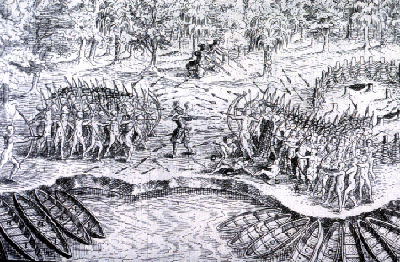
Alliances & Treaties
Champlain Battles the Haudenosaunee
Champlain and his First Nations allies battled the Haudenosaunee on Lake Champlain, beginning 150 years of war between Iroquois and French. Champlain's musket kills three and astonishes the enemy.
-
October 13, 1609

Government & Crown
Champlain Returns to France
Samuel de Champlain arrived back in France, ready to report to the king on the success of New France and extol the virtues of the Québec habitation as a warehouse for the fur trade.
-
August 08, 1610

Government & Crown
Champlain Sets Sail for France
After a disastrous year for the fur trade, Samuel de Champlain set sail for France, leaving behind 16 men under the command of Jean de Godet Du Parc.
-
January 01, 1614
Trading Posts Indigenous Peoples
Dutch Establish Trading Posts
In 1614, Dutch fur traders established trading posts on the Hudson River, one on Manhattan Island and one at Fort Orange (present-day Albany, New York). This activity marked the beginning of an intense rivalry between two commercial empires, the Dutch and the French, and between their respective Indigenous allies, the Huron-Wendat and the Haudenosaunee, both of whom were supplied with guns by their European allies (see also French-Indigenous Relations).
-
May 25, 1615
Government & Crown
Récollets Arrive
Four Récollets from France arrived at Tadoussac with Champlain, only to quickly go their separate ways. The best-known Récollet, Gabriel Sagard, later published Le Grand Voyage du pays des Hurons, an indispensable source of knowledge of Huron customs and culture.
-
April 29, 1627
Government & Crown Companies
Compagnie des Cent-Associés Founded
Cardinal Richelieu, chief minister of Louis XIII, founded the Compagnie des Cent-Associés (Compagnie de la Nouvelle France) to establish the French empire in North America. The company was granted a fur trade monopoly in the St Lawrence Valley.
-
January 01, 1632
Trading Posts
Establishment of Fort Saint-Pierre
Fort Saint-Pierre was established as a trading post by some of the shareholders in the Compagnie des Cents-Associés around 1632. The fort was in active use until 1669.
-
January 01, 1634
Exploration & Expansion Indigenous Peoples
Renewal of the Ste-Marie-Among-the-Hurons Mission
The Ste-Marie-Among-the-Hurons mission near Georgian Bay was renewed by Jesuit priests in 1634. The Huron-Wendat of the area were more interested in the trade goods of the French than their religion. Fur trade profits sustained the missionaries and allowed the Compagnie des Cents-Associés to send hundreds of settlers to the colony.
-
May 18, 1642
Trading Posts
Maisonneuve Founds Ville-Marie
Paul de Chomedey de Maisonneuve founded Ville-Marie, which was destined to become the most important trading post in New France and the future city of Montréal. Maisonneuve served as governor until 1665.
-
March 06, 1645
Government & Crown Companies
Compagnie des Habitants Formed
The Compagnie des Habitants was formed in New France when a royal edict transferred the trade monopoly for fur, held by the Compagnie des Cent-Associés, to all inhabitants of the colony. In practice, only a few of the wealthiest benefited from the change. The monopoly’s cost was the equivalent of the colony's administrative expenses plus an annual payment of 1,000 beaver skins and the promise to bring in 20 new colonists a year.
-
March 06, 1645
Government & Crown Companies
Compagnie des Habitants Formed
The Compagnie des Habitants was formed in New France when a royal edict transferred the trade monopoly for fur, held by the Compagnie des Cent-Associés, to all inhabitants of the colony. In practice, only a few of the wealthiest benefited from the change.
-
April 17, 1649

Indigenous Peoples
Wendake Defeated by Haudenosaunee
Weakened by disease and cultural interference by the French, the Huron-Wendat homeland known as Wendake was destroyed by the Haudenosaunee (Iroquois). Between 1649 and 1650, about 500 Huron-Wendat left Georgian Bay to seek refuge close to the French, in the Quebec City region. Many were either killed or adopted into Haudenosaunee nations. However, the Huron-Wendat First Nation still remains — in Wendake, Quebec.
-
January 01, 1659
Fur Traders
Radisson and des Groseilliers Explore the Great Lakes
In 1659, Pierre-Esprit Radisson and his brother-in-law Médard Chouart des Groseilliers went on an unlicensed fur trading expedition to Lake Superior and Lake Michigan. They later described finding a “great store of beaver” and the “Bay of the North Sea” that gave direct access to the region.
-
February 24, 1663

Government & Crown
New France a Crown Colony
King Louis XIV revoked the monopoly of The Compagnie des Cent-Associés and New France became a Crown colony. The king appointed a new governor and an intendant.
-
May 01, 1664
Companies
Compagnie des Indes occidentales
The Compagnie des Indes occidentales, which replaced the Compagnie des Cents-Associés, was established in May 1664 by Jean-Baptiste Colbert to drive Dutch traders from French colonies in the West Indies and the Americas, and to emulate Dutch and English commercial success. Permanent residents of New France could trade for furs with Indigenous people but had to sell the beaver and moose hides to the company at fixed prices.
-
January 01, 1665
Fur Traders
Radisson and des Groseilliers Sail to England
Pierre-Esprit Radisson and Médard Chouart de Groseilliers sailed to England, where they received support for their plan to bypass the St. Lawrence River to access the interior fur-producing region.
-
June 03, 1668
Exploration & Expansion Fur Traders Companies
Nonsuch Begins Journey from England
The Nonsuch, an English trading ship, set out to explore Hudson Bay’s potential as an access point for thefur trade. The ship successfully sailed around the bay, which led to the creation of the Hudson’s Bay Company and the commercial domain of Rupert’s Land.
-
March 07, 1670
Government & Crown
Colbert Creates the Ministère de la marine
The Ministère de la Marine, the section of the French government that administered Canada during its last hundred years as a French colony, was established. The Marine, variously described as a ministry, department, or secretariat of state, combined the administration of the navy, colonies and seaborne trade.
-
May 02, 1670
Companies
Hudson's Bay Company Founded
King Charles II of England granted a charter to Prince Rupert and his "Company of Adventurers of England trading into Hudson's Bay." The charter granted the company a monopoly of trade in the Bay and ownership of all lands drained by rivers flowing into the Bay. The HBC established an English presence in the Northwest and a competitive route to the fur trade centred on Montréal.
-
January 01, 1672
Trading Posts Fur Traders Companies
Bayly Founds Moose Factory
Charles Bayly founded Moose Fort, which would later become Moose Factory. Moose Fort was the Hudson's Bay Company's second post and the first British settlement in what is now Ontario. In 1686, it was captured by the French in a daring overland attack led by Pierre de Troyes. It was returned to the Hudson's Bay Company in 1713 by the Treaty of Utretch; trading activities resumed in 1730.
-
January 24, 1672
Companies
HBC’s First Fur Sale
The Hudson’s Bay Company’s first fur sale (an auction) took place, at Garraway’s Coffee House in London. Many of the city’s rich and influential citizens socialized at Garraway’s, and the auction became something of a gala evening, drawing London’s elite to bid on the 27 lots of furs.
-
July 01, 1673
Trading Posts
Fort Frontenac Construction Begins
Construction began on Fort Frontenac during negotiations between Governor Frontenac and a delegation of Iroquois. The fort was meant to provide protection for Ville-Marie (Montréal) and to further fur trading interests in the Great Lakes and Ohio Valley areas.
-
December 01, 1674
Government & Crown Companies
Colbert Dissolves Compagnie des indes occidentales
Jean-Baptiste Colbert dissolved the Compagnie des indes occidentales after it failed to emulate Dutch and British commercial success in the Americas. Colbert initiated the regime of direct governmental administration of colonies.
-
January 01, 1676
Trading Posts
Chicoutimi Trading Post
New France authorities built a trading post at Chicoutimi, an already important staging point on the route that Indigenous hunters took to sell their furs in Tadoussac.
-
January 01, 1676
Trading Posts
Jolliet Establishes Sept-Îles Post
Louis Jolliet established a trading and fishing post at Sept-Îles. It was ceded to the Hudson’s Bay Company in the 19th century.
-
January 01, 1677
Indigenous Peoples Alliances & Treaties
Silver Covenant Chain Treaty
This wampum treaty between Britain and the Haudenosaunee represented an open and honest communication between two peoples. Subsequent wampum treaties reinforce this idea, as well as the idea of mutual interest and peace. Such wampum treaties oblige the parties to help each other, in war if necessary, should they be asked.
-
April 01, 1679
Exploration & Expansion Indigenous Peoples
Jolliet Sent to Hudson Bay
At the behest of officials in Quebec City, Louis Jolliet embarked on a journey to Hudson Bay to survey the influence of British traders in the region, and to assess the possibility of a trade alliance between the French and Indigenous peoples in the area (see also French-Indigenous Relations).
-
January 01, 1681
Government & Crown Fur Traders
Colbert Initiates the Congé System
Jean-Baptiste Colbert inaugurated the congés system (trade licenses) in which up to 25 congés would be issued by the governor each year. The licenses allowed three men in one canoe to trade in the west. This was meant to limit the number of men away from settlements each year; however, most men went illegally anyway.
-
January 01, 1682
Indigenous Peoples Companies
Canadien Merchants Found the Compagnie du Nord
Founded in 1682 by Canadien merchants to trade into Hudson Bay by sea, the company upheld French claims on the bay by dispatching Pierre-Esprit Radisson and Médard Chouart des Groseillers there with two ships. This stabilized New France's Indigenous alliances north of the Great Lakes.
-
January 01, 1684
Trading Posts
Founding of York Factory
The first York Factory outpost, named after the governor of the Hudson’s Bay Company, the Duke of York, was constructed on the narrow peninsula that separated the Hayes and Nelson rivers. The location was key to trade, as both rivers flowed from the heart of fur trading territory to the shores of Hudson Bay.
-
January 01, 1688
Indigenous Peoples
Iroquois Besiege Fort Cataraqui
By 1688, relations between the French and Iroquois had soured. In that year, a force of Iroquois warriors laid siege to Fort Frontenac, then known as Fort Cataraqui. Ninety-three French soldiers died of scurvy during the long siege.
-
August 05, 1689
Indigenous Peoples
Lachine Raid
Lachine was attacked by 1,500 Haudenosaunee in the fiercest assault in the history of the colony; 24 French colonists were killed, and 42 of 90 prisoners never returned.
-
January 01, 1694
Trading Posts
Cadillac Takes Over Fort Michilimackinac
In 1694, Antoine Laumet, dit de Lamothe Cadillac became commandant of Fort Michilimackinac (also known as Fort de Buade), located at the junction of Lake Huron and Lake Michigan. Although the fort was of crucial military importance given the war with the Iroquois, Cadillac was more interested in the fur trade and selling alcohol than in military strategy. He proved to be a poor commandant.
-
January 01, 1696
Government & Crown
French Crown Suspends Fur Trade
In 1696, the French Crown tried to suspend the fur trade, the issuing of congés and to abandon all French trading posts in the West apart from Saint-Louis-des-Illinois, due to the huge beaver pelt surplus. Eventually the ban was rescinded.
-
September 30, 1697
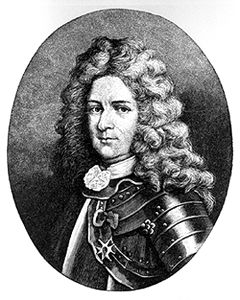
Government & Crown
Treaty of Ryswick
The Treaty of Ryswick between England and France provided for the restoration of all Hudson's Bay Co posts seized by Pierre le Moyne d'Iberville.
-
January 01, 1699
Government & Crown Companies
Compagnie de la Colonie
The Compagnie de la Colonie was created in 1699 and gave Canadiens a monopoly over the fur trade. Until 1705, roughly 60 young men travelled as voyageurs on behalf of the Compagnie de la Colonie, reaching as far as the post of Detroit. They earned a modest wage for their efforts. Established during a period of decline in the French beaver pelt market, the Compagnie eventually dissolved in 1706 and the French Crown enjoyed a monopoly once again.
-
August 01, 1701
Government & Crown Indigenous Peoples Alliances & Treaties
Great Peace of Montreal
Three dozen Indigenous groups and the French colonial government sign the Great Peace of Montréal, forging peaceful relations that end nearly a century of war between the Haudenosaunee and the French (and their Indigenous allies).
-
August 01, 1701
Indigenous Peoples Alliances & Treaties
Great Peace of Montreal
The Great Peace of Montreal was signed between 39 First Nation tribes and the French colonial government. The peace brought an end to almost a century of hostilities marked by atrocities on both sides known today as the Iroquois Wars or Beaver Wars.
-
April 11, 1713
Government & Crown Alliances & Treaties
Treaty of Utrecht Signed
The Treaty of Utrecht was signed, ending the War of the Spanish Succession. It recognized the claim of the Hudson's Bay Co to Rupert's Land, and Acadia became a permanent English possession.
-
January 01, 1715
Fur Traders
Fur Trade Revives
The surplus of beaver fur in French warehouses was found to be destroyed by rodents and insects, reviving the fur trade market's demand for beaver pelts
-
January 01, 1717
Trading Posts
Knight Establishes Prince of Wales Fort
The Hudson’s Bay Company’s first permanent post on the Churchill River was built by Hudson’s Bay Company governor James Knight, about 8 km from the mouth of the river on Hudson Bay. It was called, Churchill, Churchill River and Churchill Factory until the name was formally changed to Prince of Wales Fort in 1719.
-
August 26, 1731

Trading Posts Fur Traders
La Vérendrye at Grand Portage
La Vérendrye and his three sons reached Grand Portage. In the autumn they built Fort Saint-Pierre, the first of 8 posts.
-
August 26, 1731
Trading Posts
La Vérendrye at Grand Portage
Pierre Gaultier de Varennes et de La Vérendrye and his three sons reached Grand Portage after being granted a fur trade monopoly by the French crown. In the autumn they built Fort Saint-Pierre at Rainy Lake, the first of eight posts that the family founded.
-
October 03, 1738

Trading Posts
Fort La Reine Founded
La Vérendrye arrived at the site of Portage-la-Prairie on the Assiniboine River, where he built Fort La Reine.
-
October 03, 1738
Trading Posts Fur Traders
Founding of Fort La Reine
Pierre Gaultier de Varennes et de La Vérendrye arrived at the site of Portage la Prairie on the Assiniboine River, where he built Fort La Reine. After 1794, both the North West Company and Hudson’s Bay Company maintained trading posts at the Portage la Prairie site from the Assiniboine River to Lake Manitoba.
-
April 01, 1751
Trading Posts Alliances & Treaties
Construction Finishes at Fort Rouillé
Construction of French Fort Rouillé was finished in April 1751 and soon proved its worth in helping to build a French alliance with the First Nations of the region. In the 17th and 18th centuries, a foot path up the Humber River was the forerunner of today's Highway 400 — a key transportation route connecting Lake Ontario and Georgian Bay. It was on that path that Indigenous traders carried valuable furs to Lake Ontario and to the English post at Oswego. Fort Rouillé was constructed to help the French intercept this trade.
-
April 01, 1754
Trading Posts Alliances & Treaties
French Establish Fort Duquesne
A French force under Sieur de Contrecoeur drove off the English from the area in April 1754. The French built Fort Duquesne to serve as a military stronghold and as a base for developing trade and strengthening military alliances with the Indigenous peoples of the area.
-
September 17, 1760
Government & Crown
French Capitulate at Montreal
The French capitulate in Montreal and the English take possession of the city after the Seven Years’ War. The fur trade was revived once more, now supported by British capital and Canadian labour.
-
January 01, 1774
Companies
Hudson’s Bay Company Builds Cumberland House
The Hudson’s Bay Company built Cumberland House in Saskatchewan. This marked a change in Hudson’s Bay Company policy, as the company had previously expected Indigenous people to bring their furs to the trading posts and factories.
-
January 01, 1776
Trading Posts
Frobisher Establishes Fur Trade Post at Île-à-la-Crosse
Montreal-based trader Thomas Frobisher built the first fur trade post in the area of Île-à-la-Crosse in 1776. Competing posts were set up by Alexander Mackenzie in 1785 and the Hudson's Bay Company in 1799.
-
April 24, 1779

Companies
North West Company Formed
The North West Company was formed in Montreal, with 16 shares.
-
August 01, 1782
Indigenous Peoples
Death of Matonabbee
Matonabbee, a Chipewyan leader and important intermediary in the fur trade between the Hudson’s Bay Company and Dene tribes, committed suicide when the French destroyed the Prince of Wales Fort, an important position in the fur trade that was linked to Matonabbee’s fortunes. In the 1770s, Matonabbee made Samuel Hearne’s journey to the Arctic Ocean possible with his leadership and knowledge of Indigenous ways of travel and living off the land.
-
January 01, 1783
Trading Posts Companies
North West Company Establishes Sault Ste Marie Post
The North West Company built a post in Sault Ste Marie. It helped develop the fishery as a major food source for the fur trade. The NWC dug the first canal past the rapids in 1798 to move boats and canoes.
-
January 01, 1786
Trading Posts Companies
North West Company Establishes Fort Resolution
The North West Company established a trading post on the site of Fort Resolution in 1786. The Hudson’s Bay Company established a post in 1815, and when the companies united in 1821, the post was called Fort Resolution.
-
January 01, 1787
Companies
McTavish and Frobisher Establish New Company
Simon McTavish and Joseph Frobisher formed McTavish, Frobisher and Co in 1787 which became the main outfitter and sales agent for the North West Company. Through this, MacTavish’s control of the North West Company tightened.
-
January 01, 1788
Trading Posts
Mackenzie Establishes Fort Chipewyan
The community of Fort Chipewyan, Alberta, was established in 1788 by Roderick Mackenzie, cousin of Sir Alexander Mackenzie, as a trading post for the North West Company. It became an entrepôt for northern and western exploration and the expanding fur trade. It was also the scene of fierce struggles between the North West Company, theXY Companyand theHudson’s Bay Company, which culminated in the Hudson’s Bay Company gaining control of the fort in 1821.
-
January 01, 1788
Trading Posts
Community of Fort Vermilion Established
Boyer’s Post on Peace River, later renamed Fort Vermilion, was established around the same time as the original Fort Chipewyan, making Fort Vermilion and Fort Chipewyan arguably Alberta’s oldest communities settled in part by people of European descent. The post moved to its present site around 1831.
-
September 20, 1788
Exploration & Expansion Fur Traders
North West America Launched
The North West America, the first European vessel built on the BC coast, was launched by John Meares, sea captain, entrepreneur and fur trader. The ship was used in the trade for sea otter pelts.
-
June 03, 1789
Exploration & Expansion
Mackenzie Sets Out on Expedition
Sir Alexander Mackenzie, partner in the North West Company and leader of several trading posts, began an expedition with a party of voyageurs and Indigenous guides to search for the Pacific Ocean. Instead, the party reached the Arctic Ocean. Although this added to European geography knowledge, Mackenzie felt it was a failure as he had not reached the Pacific and thus, failed to open new trade routes for his company.
-
July 21, 1793

Exploration & Expansion
Mackenzie Reaches the Pacific
Alexander Mackenzie party reached the Pacific via the Bella Coola River, the first explorer to complete the journey overland. Though a physical triumph, Mackenzie's achievement failed to provide the fur traders with a viable route.
-
January 01, 1794
Trading Posts
First Fort at Fort St John
The first fort at Fort St. John (British Columbia) was built by the North West Company and named Rocky Mountain Fort in 1794. It was later renamed Fort St. John by the Hudson’s Bay Company in 1821. The Hudson’s Bay Company fort would be relocated three more times near the site of the present-day city; the last one at Fish Creek (1925–75).
-
November 19, 1794
Alliances & Treaties
Jay's Treaty Passed
By Jay's Treaty, the British agreed to evacuate frontier posts by 1796. US shipping would have access to British possessions.
-
January 01, 1795
Trading Posts Companies
Hudson’s Bay Company Establishes Fort Edmonton
Fort Edmonton was established on the North Saskatchewan River by the Hudson’s Bay Company as a fortified trading post next to the rival North West Company, which had earlier built its own fort nearby. After the amalgamation of the two companies in 1821, Fort Edmonton emerged as the leading centre of the Saskatchewan district fur trade.
-
January 01, 1796
Fur Traders
Joseph Lewis Enters into Contract with the North West Company
In 1796, Black fur trader Joseph Lewis entered a three-year contract as a steersman with the North West Company. Over the next decades of his career, Lewis served at several important fur trading centres, and participated in an expedition over the Rocky Mountains in 1810–11. Lewis was one of only a few Black people documented by name who worked in the fur trade in Canada’s early North-West. He is quite likely the first Black person to have settled in present-day Saskatchewan.
-
January 01, 1797
Trading Posts
Construction Begins on Fort St Joseph
Fort St. Joseph was built by the British between 1797 and 1805. The most westerly British post, it was important to the fur trade and alliances with Indigenous peoples of the region.
-
January 01, 1798
Companies
XY Company Founding
The XY Company was founded in 1789 after conflicts arose between North West Company agents, led by Simon McTavish, and North West Company winterers (who then split from McTavish and the company) following the North West Company’s reorganization in 1795. In 1800, Alexander Mackenzie joined the new company, which then became popularly known as “Alexander Mackenzie & Co.”
-
January 01, 1803
Trading Posts
North West Company Builds Fort William
The North West Company built a new fort at its Lake Superior headquarters, replacing Grand Portage, which had come under US jurisdiction. Until 1821, Fort William served as the summer meeting place of Montreal agents and wintering partners, as well as the company’s major shipping point for furs and other trade goods. The post gradually declined until it closed in 1883.
-
January 01, 1804
Trading Posts
Fort of the Forks
Fort of the Forks was built by the North West Company in 1804. It was renamed Fort Simpson in 1821 after governor Sir George Simpson of the Hudson’s Bay Company. It was the oldest continuously occupied trading post on the Mackenzie River.
-
October 05, 1804
Companies
XY Company and North West Company Unite
The fur trading companies XY, popularly known as “Alexander Mackenzie & Co.,” and the North West Company amalgamated.
-
November 05, 1804
Companies
XY and NWC Unite
The fur-trading XY and North West companies amalgamated.
-
January 01, 1805
Trading Posts
Fort Good Hope
Established by the North West Company in 1805, Fort Good Hope was the oldest fur-trading post in the lower Mackenzie Valley.
-
January 01, 1805
Trading Posts
Operations Begin at Dunvegan
Dunvegan Post commenced operations in 1805. It was one of the most important fur trade sites on the Peace River. The post was built by Archibald Norman McLeod of the North West Company to trade with the Beaver and other First Nations who lived near the river. After 1821, the Hudson’s Bay Company operated the post, which was noted for its productive gardens and as a source of meat and leather for other posts in the district.
-
January 01, 1805
Trading Posts
Establishment of Fort Nelson
W. Ferdinand Wentzell of the North West Company sent George Keith to establish a post at Fort Nelson in 1805, making it the third oldest European settlement in British Columbia. The post was abandoned in 1813 but later re-established by the Hudson’s Bay Company in 1865.
-
January 01, 1805
Exploration & Expansion
Simon Fraser Heads West
Explorer and fur trader for the North West Company, Simon Fraser was selected to expand the company’s operations beyond the Rocky Mountains. He founded the first European settlements in central British Columbia, establishing Fort McLeod in 1805, Fort St James and Fort Fraser in 1806, and Fort George (now Prince George) in 1807.
-
January 01, 1806
Trading Posts
Fraser Establishes Fort St. James
Simon Fraser established Fort St. James on Stuart Lake as a North West Company post in 1806. It became the oldest continuously inhabited European community in British Columbia. New Caledonia, the area surrounding the fort, was a trading district for the North West Company and was headquartered at Fort St. James.
-
June 29, 1806
Fur Traders
Isobel Gunn Sets Sail for Rupert's Land
The Prince of Wales set sail from Stromness, Scotland for Rupert’s Land. Aboard the ship was Isobel Gunn, a woman who disguised herself as a man and went by the alias John Fubbister in order to work for the Hudson’s Bay Company. Her true identity was discovered two years later after she gave birth to a son.
-
January 01, 1810
Trading Posts
Hudson’s Bay Company Establishes Fort Carlton
Fort Carlton was established in 1810 as a Hudson’s Bay Company fur trade and provision post. Initially called Carlton House, two previous posts had been in the area in 1795 and 1804 before being abandoned permanently for the present location. Until 1882, Fort Carlton remained an important fur trade depot in Western Canada.
-
June 23, 1810
Companies
Pacific Fur Company
The Pacific Fur Company was established to trade furs in the Northwest and on the Pacific Coast. The company was headed by New York fur dealer John Jacob Astor.
-
June 23, 1810

Companies
Pacific Fur Company
The Pacific Fur Company, headed by New York fur dealer John Jacob Astor, was established to trade furs in the Northwest and on the Pacific Coast.
-
June 12, 1811

Exploration & Expansion Companies
Selkirk's Red River Grant
The HBC granted an area of about 185 000 km² to Lord Selkirk for formation of a colony at Red River. His first settlers arrived in the summer of 1812. Despite tribulations the settlement grew into the first European colony in the North-West.
-
January 01, 1812
Trading Posts Indigenous Peoples
Hudson’s Bay Company Establishes Post at Turtle River
Peter Bostonais Pangman, a Métis leader and fur trader, joined John McLeod Sr., chief trader for the Hudson’s Bay Company, to travel up the Red River and establish a trading post at the fork of Turtle River (today’s Grand Forks).
-
September 01, 1812
Trading Posts
Founding of Fort She-whaps
David Stuart of the Pacific Fur Company spent the winter of 1811 in the area of Kamloops and was impressed with the fur trading possibilities he found there. As a result, he built the first trading post in the area in September 1812 and called it Fort She-whaps.
-
October 01, 1812
Trading Posts
Building of Fort Thompson
In November 1812, the North West Company installed a fort in the area of Fort She-whaps and called it Fort Thompson. The Hudson’s Bay Company took over trade in the area after its merger with the North West Company in 1821.
-
January 08, 1814
Government & Crown
Governor Declares Pemmican Proclamation
Miles Macdonell, the governor of Assiniboia, issued a proclamation on behalf of Lord Selkirk and the Hudson’s Bay Company which established the boundaries of the territory of Assiniboia and forbade the export of any provisions (which for fur traders consisted chiefly of pemmican) from said territory for a year. The declaration angered many Métis and North West Company traders who saw the move as a direct sanction against them even though it applied to all companies. The proclamation ultimately led to violence in the Seven Oaks Incident.
-
July 17, 1814
Government & Crown Trading Posts Indigenous Peoples
Capture of Prairie du Chien
British, Canadian and Winnebago, Sac and Sioux forces recaptured a Canadian fur trading post at Prairie du Chien in Wisconsin Territory after a three-day battle. It had been captured on 2 June 1814 by American militia and regulars under Governor William Clark.
-
July 17, 1814
Trading Posts
Capture of Prairie du Chien
British, Canadian and Winnebago, Sac and Sioux forces recaptured a Canadian fur trading post at Prairie du Chien in Wisconsin Territory after a three-day battle with the Americans. The post had been captured on 2 June 1814 by American militia and regulars under the command of Governor William Clark.
-
July 20, 1814
Trading Posts
Burning of Fort St. Joseph
An American expedition to the Upper Great Lakes arrived off St. Joseph Island. A shore party burned the abandoned British fort and the fur traders' storehouses.
-
June 19, 1816

Indigenous Peoples
Battle of Seven Oaks
About 60 Métis and First Nations men, led by North West Company clerk Cuthbert Grant, were confronted at Seven Oaks by Hudon's Bay Company Governor Robert Semple and 28 men (mostly HBC officers and employees). The gunfire and hand-to-hand combat that resulted left Semple and 20 of the HBC party dead. On the Métis side, 16-year-old Joseph Letendre died, and Joseph Trottier was wounded. The battle was a culmination of the Pemmican Wars and the escalating fur trade disputes between the HBC and NWC.
-
August 13, 1816
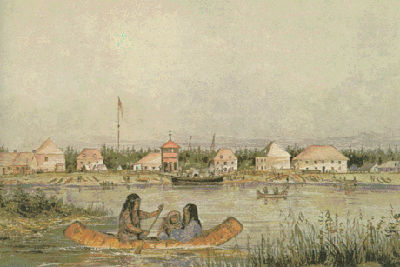
Companies
Selkirk Seizes Fort William
Lord Selkirk seized the North West Company's western depot at Fort William.
-
August 13, 1816
Companies
Selkirk Seizes Fort William
Lord Selkirk and his men seized the North West Company’s western depot at Fort William. They accused the North West Company men of murder and arrested their officers. Lawsuits and countersuits followed.
-
March 21, 1821

Companies
Fur Empires Merge
Agreement was reached to merge the North West Company and the Hudson's Bay Company as of June 1, effectively ending the fur trade out of Montréal and creating a near monopoly of the fur trade in British North America.
-
January 01, 1822
Companies
Hudson’s Bay Company Establishes Upper Fort Garry
Upper Fort Garry, situated at the forks of the Red and Assiniboine rivers in the heart of the Red River Colony (Manitoba), was established by the Hudson's Bay Company. Previous fur trade posts had been located periodically in the area. In 1826, severe flood damage prompted the construction of a new post, Lower Fort Garry, 32 km downriver.
-
January 01, 1823
Trading Posts
Fort Assiniboine
Fort Assiniboine, the first documented fur trade site at the confluence of the Freeman and Athabasca rivers in Alberta, was established in 1823, although there may have been earlier posts in the area. After George Simpson had a trail cut from Fort Edmonton to Fort Assiniboine, Fort Assiniboine became a transportation centre for goods carried by pack horse from Fort Edmonton to posts at Lesser Slave Lake (established in 1802), Jasper House, and Dunvegan
-
January 01, 1824
Fur Traders
Peter Skene Ogden Traps in Snake River Country
Peter Skene Ogden, one of the most important figures of the North American fur trade, was sent by the Hudson’s Bay Company on a series of trapping expeditions to the Snake River country in 1824. He was meant to trap the area bare as it was assumed that this area south of the Columbia River would eventually go to the United States.
-
March 19, 1825

Trading Posts
Founding Fort Vancouver
The Hudson's Bay Company established Fort Vancouver on the Columbia River, near present-day Portland, Oregon.
-
January 01, 1826
Fur Traders Companies
John Rowand Becomes Chief Factor
John Rowand became a chief factor of Fort Edmonton for the Hudson’s Bay Company in 1826. He had learned the fur trade as a clerk for McTavish, Frobisher & Co. and had also been head and chief trader of the Hudson’s Bay Company’s Saskatchewan district. He held the position of chief factor until his death almost 30 years later.
-
July 30, 1827
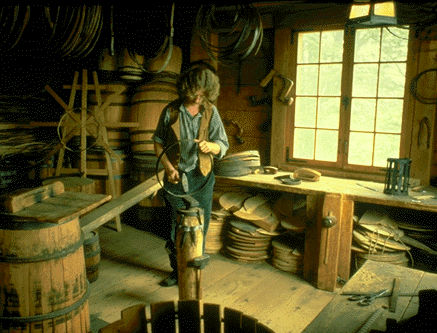
Trading Posts
Construction of Fort Langley
Construction began on the Hudson's Bay Company post of Fort Langley, at the mouth of the Fraser River.
-
January 01, 1830
Trading Posts
Fort Pitt
Founded in 1830, Fort Pitt was the most important Hudson’s Bay Company trading post between forts Edmonton and Carlton, in Saskatchewan.
-
January 01, 1831
Trading Posts
C.T. William Todd Founds Fort Ellice
Established in 1831 by C.T. William Todd, Fort Ellice (on the modern Manitoba-Saskatchewan border) was intended to protect from claims to Hudson's Bay Company lands from venturing American interests, as well as to sell provisions such as pemmican, tools and traps to passing traders. In 1862, the modest installation was replaced by a larger and more elaborate structure approximately 2 km east.
-
May 04, 1836

Companies
Assiniboia Transferred
The territory of Assiniboia was transferred to the Hudson's Bay Company by Lord Selkirk's family.
-
January 01, 1837
Fur Traders Companies
Samuel Black Becomes HBC Chief Factor
Samuel Black, a former North West Company partner who had once been a fierce opponent of the Hudson’s Bay Company, became chief factor for the HBC for all Thompson River district posts. He had previously been a clerk and a chief trader for the company.
-
June 24, 1837

Indigenous Peoples
Smallpox Hits Prairies
An American Fur Company boat arrived at Fort Union, setting off a smallpox epidemic across the praries, killing an estimated three-quarters of the Blackfoot, Blood, Peigan, Sarcee and Assiniboine peoples of the prairies.
-
January 01, 1840
Trading Posts
John Bell Opens Peel’s River Post
In 1840, John Bell opened Peel’s River Post (now Fort McPherson), the most northerly Hudson’s Bay Company post at the time. Bell had previously been the chief clerk at Fort Good Hope.
-
January 01, 1842
Companies
Hudson’s Bay Company Leases King’s Posts
The Hudson’s Bay Company acquired the lease for the King’s Posts in Lower Canada in 1842. However, the importance of the fur trade in the region was lessening significantly. The Hudson’s Bay Company countered this by becoming an important supplier of goods needed by the increasing number of lumber crews.
-
February 16, 1842
Fur Traders
Death of William McIntosh
William McIntosh, fur trader and wintering partner in the North West Company, died. McIntosh was arrested at Grand Rapids in 1819, along with several other senior North West Company men, by the governor-in-chief of the Hudson’s Bay Company. McIntosh pretended illness, feigned suicide and escaped to Fort William. In the two preceding years, he completely disrupted the Hudson’s Bay Company’s attempts to capture the Athabasca country. After the 1821 union of the North West Company and Hudson’s Bay Company, McIntosh served as a chief trader and after 1823 as a chief factor at various trading posts, serving the company for 16 years.
-
June 10, 1843
Trading Posts
Hudson’s Bay Company Christens Fort Victoria
In 1842, Sir James Douglas of the Hudson’s Bay Company selected the port of Camosack (the harbour where the city of Victoria now stands) as a new fur trade post. The goal was to eventually replace Fort Vancouver (now Vancouver, Washington) as the company’s Pacific headquarters and to bolster the British claim to Vancouver Island. First known locally as Fort Albert, the fort was officially christened Fort Victoria, in honour of Queen Victoria, on 10 June 1843.
-
June 15, 1846
Government & Crown Alliances & Treaties
Oregon Boundary Treaty
The Oregon Treaty between the United States and Britain was signed, establishing the boundary between British North America and the US at 49° North latitude. This left Vancouver Island in British hands and created a situation in which Canada and the US could live in harmony. The treaty’s boundaries forced the Hudson’s Bay Company to withdraw from its trading posts south of the 49th parallel, such as Fort Vancouver, and to focus its activities solely in the North.
-
June 15, 1846

Government & Crown
Oregon Boundary Treaty
The Oregon Boundary Treaty was signed, establishing the boundary between British North America and the US at 49° north latitude, leaving Vancouver Island in British hands, and creating a settlement with which Canada and the US could live in harmony.
-
January 01, 1848
Trading Posts
Hudson’s Bay Company Established Post at Hope
Hope was established in 1848–49 as a Hudson's Bay Company trading post. Located at the Western end of the Brigade Trail from Fort Kamloops, it was named Hope with the aspiration that the trail would provide an all-British route between Forts Kamloops and Langley.
-
May 17, 1849
Indigenous Peoples
Sayer Trial
Pierre Guillaume Sayer and 3 other Métis in the Red River Colony were brought to trial on charges of violating the Hudson's Bay Company's charter by illegally trafficking in furs.
-
May 30, 1858
Companies
Hudson's Bay Co Charter Revoked
The Hudson's Bay Co charter to what is now mainland British Columbia was revoked.
-
January 01, 1863
Companies
International Financial Society Buys the Hudson’s Bay Company
In 1863, the International Financial Society bought controlling interest in the Hudson’s Bay Company, marking the beginning of the end of the historic fur trade. This signalled a shift in the company’s outlook, as most of the new shareholders were less interested in the fur trade than in real estate speculation and economic development in the West.
-
December 01, 1869
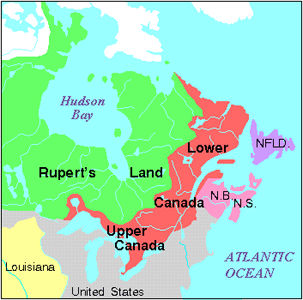
Companies
HBC Surrenders Rupert's Land
The Hudson's Bay Company surrendered Rupert's Land to the Canadian government.
-
August 02, 1877
Government & Crown Fur Traders
Death of Sir James Douglas
Sir James Douglas, governor of Vancouver Island (1851–64) and British Columbia (1858–64) and a former fur trader, died in Victoria, British Columbia. Known as the “father of British Columbia,” Douglas helped the Hudson’s Bay Company become a trading monopoly in the Pacific Northwest and initiated British rule west of theRocky Mountains.
-
April 14, 1885
Indigenous Peoples
Big Bear Besieges Fort Pitt
On 14 and 15 April 1885, during the North-West Rebellion, Chief Big Bear's Cree band besieged Fort Pitt, the major Hudson’s Bay Company trading post between forts Edmonton and Carlton. They took the civilian occupants prisoner and looted the post.
-
January 01, 1930

Companies
Hudson’s Bay Company Beaver Management Program
During the Depression, the HBC saw decreased demand for beaver furs, and realized that to keep the price competitive the number of furs taken in Northern Québec would have to be limited. The company’s main suppliers in the area, the Cree, were also suffering because the beaver had been over-trapped. The company embarked on a conservation program that put the Cree in charge of a sanctuary system, a program that was successful and lasted into the 1950s.


